It’s peony time! It’s been beckoning for weeks, fat green buds perching tantalizingly on ever-reaching stems. Firmly closed, withholding their beauty, they take their sweet time until at last, one day, the first cerise petal curls ever so slowly outward.
Will I, or won’t I? Is it warm enough? Is there enough sun? Not too much rain? Hmmm. Let me think about it. Oh, all right. I will bloom this year.
After that, it’s a free-for-all. Blooms bursting left and right in an exuberant display.
I try not to be greedy, and pick just enough for a table, leaving most of the blooms in place to delight us in their garden setting.
Three glorious bunches sashayed into ironstone jugs and danced onto the table.
Nodding courteously to each other, they positioned themselves like ballerinas taking their places on stage.
Each the principal dancer between her partner place settings.
Strathmore Blue Ironstone by Mason’s dinner and salad plates floated into position on wicker chargers.
Yes, the china and glasses are very pretty, but we’re real stars, murmur the peonies.
Too true!
But … the china really is very, very pretty. The delicate yet exuberant floral bouquet belies the very sturdy nature of the ironstone body of the plates.
Mason’s Patent Ironstone has a fascinating history. The founder of the company, Miles Mason, was born in 1752 in Dent, in the West Riding of Yorkshire, and embarked on a career in ceramics entirely by chance. He began his working life as clerk to his Uncle Bailey, who was a stationer in London. As luck would have it, his next door neighbour was Richard Farrar, a prosperous glass and china merchant who sold mainly porcelain imported from China.
Richard Farrar’s untimely death in 1775 left his nine-year old daughter, Ruth, heir to his vast estate, which included a personal fortune in excess of $55,000. She and Miles Mason married seven years later and went on to found a ceramics dynasty through their four children, a daughter, Ann Ruth, and three sons William, George Miles and Charles James.
The youngest son, Charles James (or CJ as he was known) was the one with the most interest and the true entrepreneur of the four. Born in 1791, CJ became one of the outstanding figures in the Staffordshire pottery industry, and when people today speak of “Ironstone” it is invariably Mason’s to which they refer and to CJ’s work in particular.
From a very early age, he assisted his father in the factory, busily experimenting with new clays. He enjoyed the life and soon became a master-potter himself. Then at the tender age of 21, he was catapulted into the limelight when he registered the patent for Patent Ironstone China, a durable, heavy earthenware with a clay body containing china stone.
The name ‘Ironstone China’ was a marketing triumph, though not factually accurate – its iron content was less than half of one percent. The word “China” was equally misleading – it wasn’t from the East nor was it porcelain. But naming it “Ironstone” was a stroke of marketing genius: it was immediately identifiable, it conveyed high quality, and most of all, it implied that the earthenware was as hard and durable as iron. It was an immediate success. Readily available and reasonably priced, public demand soared. Even in its earliest days, Mason’s Ironstone reached extraordinary levels of technical and artistic excellence, for Charles employed only the best painters and craftsmen.
Mason’s Ironstone closely resembled the Chinese ceramics the wealthier classes had been buying throughout the eighteenth century: multi-piece dinner services featuring tureens topped with hare’s head handles, large vases with dragon-shaped handles for display in prominent places and a host of other useful items. Traditionally decorated in the strikingly Imari palette, they displayed rich enamel colours of mazarine blue and brick red, with brilliant gilding and accents of vivid green.
CJ also made a very fortuitous alliance; in 1815 he married Sarah Spode, who was the granddaughter of Josiah Spode, founder of the famous potting family. A very shrewd businesswoman, she encouraged her husband in all his new ventures and they remained happily married for 27 years. They had two children: Florence Elizabeth Mason and Charles Spode Mason.
Thus began a period of enormous prosperity for the Mason family which lasted well into the 1840s. Charles took on a partner, Samuel Farraday, and they were soon exporting their wares to Europe and to America, where Ironstone proved extremely popular. The total proceeds of one auction in 1822 was in excess of £30,000, equalling several million of today’s dollars. In 1828, one of their auction sales in London comprised 1004 lots, announced at $50 and $80 per lot, and all sold.
Alas, it was not to continue. (Don’t you hate it when the story has an unhappy ending)? By the mid-1840s, strong competitors had entered the market. Consumer’s tastes had moved on from Imari style to European porcelain and Mason’s had failed to keep up with the times. Sarah, Charles’ wife, died in 1842 followed rapidly by his business partner, Samuel Farraday, who passed on in 1844.
It all proved too much for Charles. Beset with debts, he declared bankruptcy in 1848. He sold the business privately to Francis Morley and it became listed as Mason & Morley. Ironically, in 1855, Francis Morley won a first-class medal at the first Paris Exhibition for his selection of Mason’s Ironstone ware.
Charles James Mason died on February 5th, 1856. He was buried beside his wife, Sarah Spode, in Barlaston Churchyard.
The Mason’s Patent Ironstone tale doesn’t end there, however. Francis Morley joined forces with Taylor Ashworth and from 1859-1862 the company traded publicly as Morley & Ashworth. Ashworth Ironstone is as famous as Mason’s, and I didn’t realize it was the same company until I began doing some digging. In fact, it was known as G.L. Ashworth & Brothers for over a hundred years (1862-1968), before the Ashworth brand reverted to “Mason’s Ironstone China”. The company was sold to the Wedgwood Group in 1973.
I have a couple of sets of Ashworth Ironstone, in the Imari style and love both of them. This one in rich greens and rusts.
And this one that we lugged home in suitcases from York, England. I’ve styled it two ways. One with turquoise and rust glasses
And with the same rust glasses and some amber stemmed depression glass (I still have to post this one – this is a teaser):
But onto Strathmore Blue, a pattern produced after 1920, and much more in the European Porcelain style. Isn’t it puuurty?
I have only six dinner and six salad plates. Oh, and three jugs.
The body of the plate is a creamy white, predominantly accented in luscious blue. The touches of vibrant green, soft pink and yellow add a soupcon of contrast. Yum.
Perfect with peonies dancing in three differently shaped jugs. The one on the left and its mate on the far right have a traditional round bottom, though the one on the left one is bigger.
The jug in the centre is known as a Fenton Jug, with an octagonal shape.
I used tumblers and goblets from the same era. The goblet is wheel-cut glass from an unknown manufacturer (from Elise Abram’s Antiques) and the blue tumbler is a Royal Lace Cobalt Blue nine ounce tumbler by Hazel Atlas. The napkins are Wheaton Stripe in soft pink from Pottery Barn and the Silver Hammered napkin rings are from Pier 1.
My little cobalt blue bird open salt flew in to join the party.
It’s so great to be dining outdoors again! The garden is thriving with all the rain; the new plantings are most appreciative. I’m less appreciative. A little more sunshine would not go amiss, she grumbles.
Thanks for joining me on this trip down Mason’s history and for one of the few fine days we’ve had this soggy June.
I’m sharing this post with Between Naps on the porch.

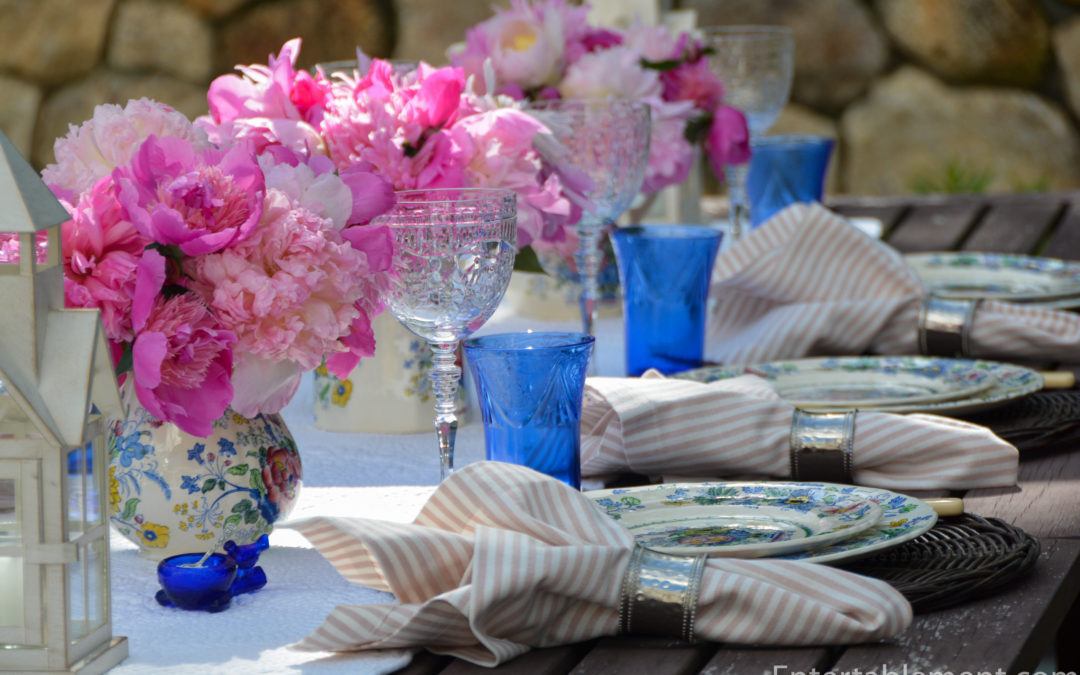







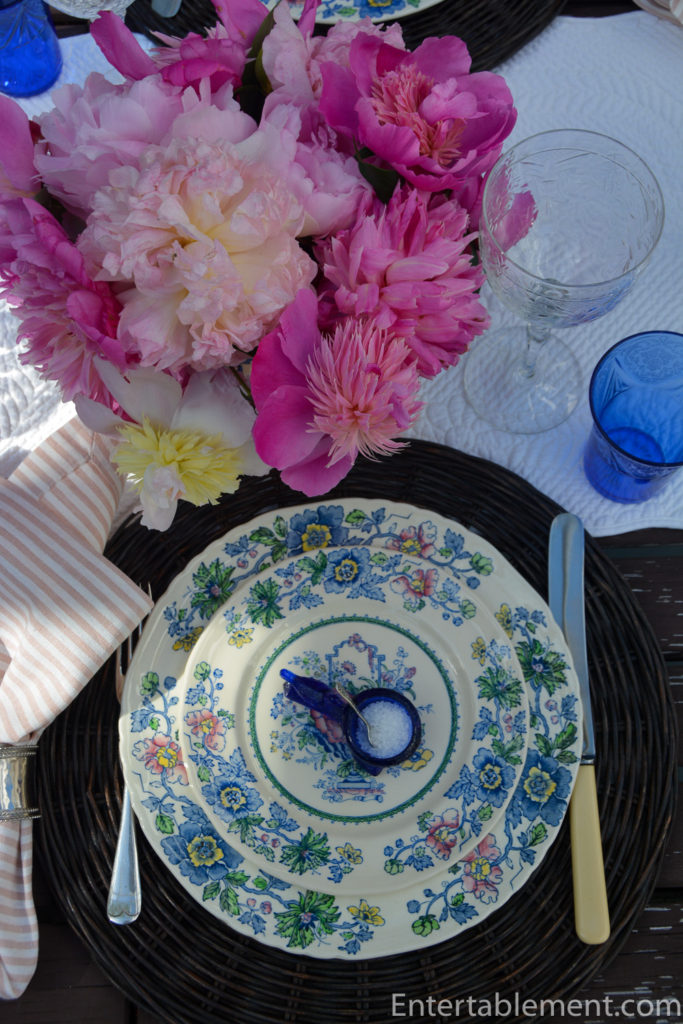

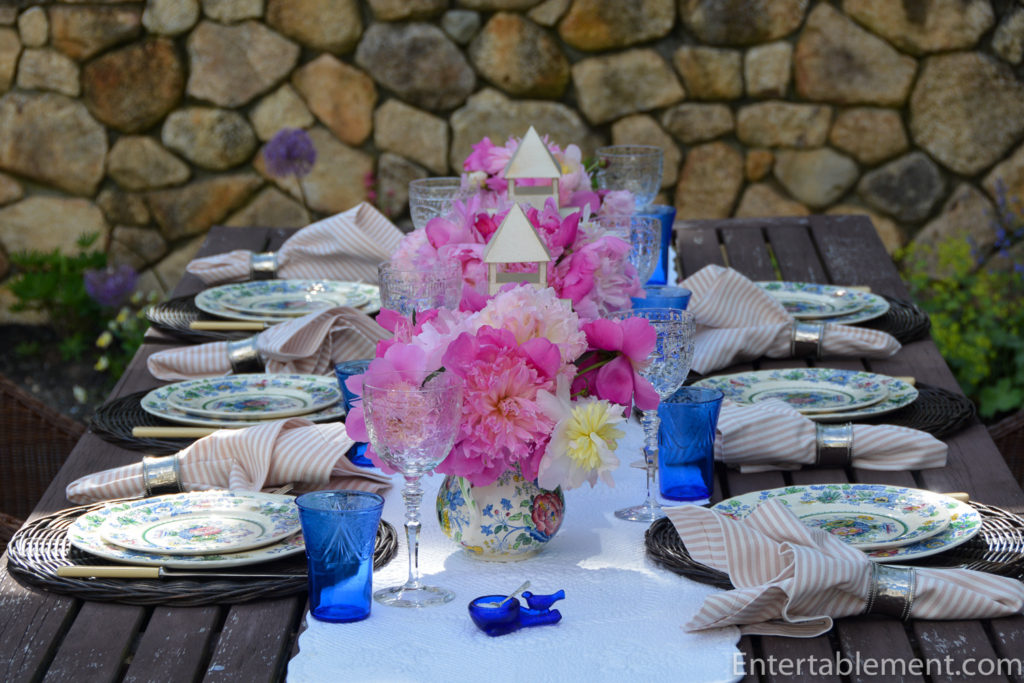
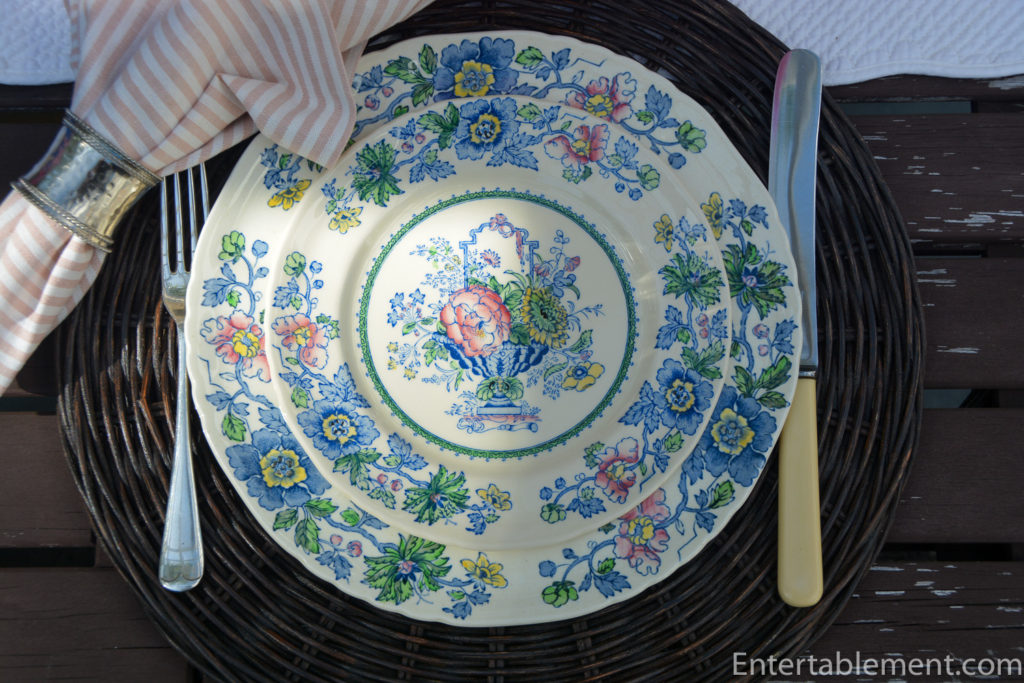
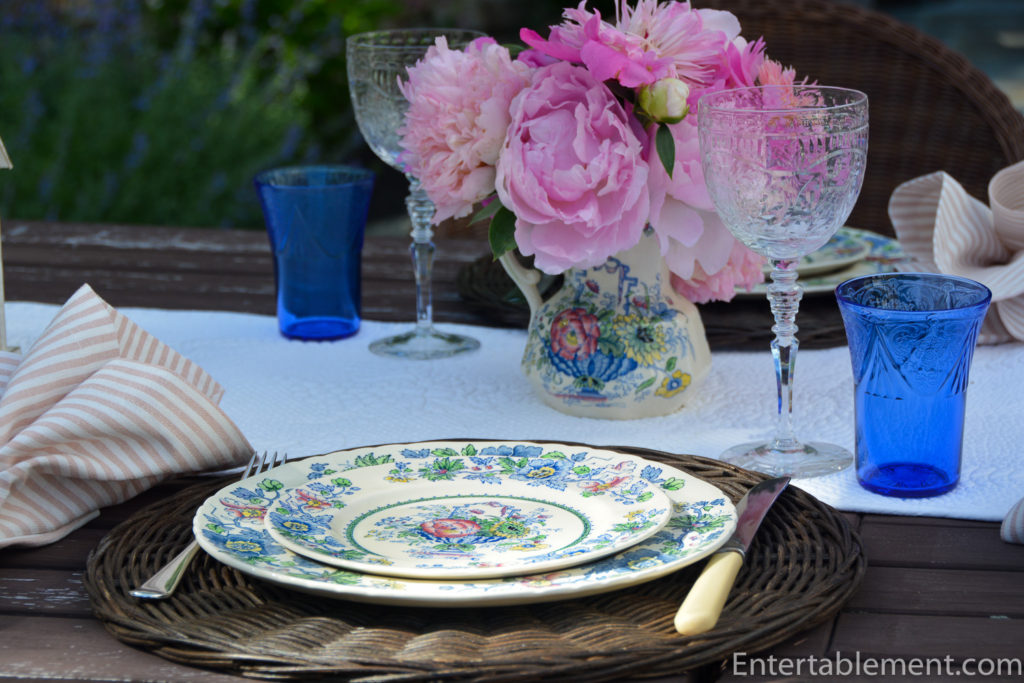





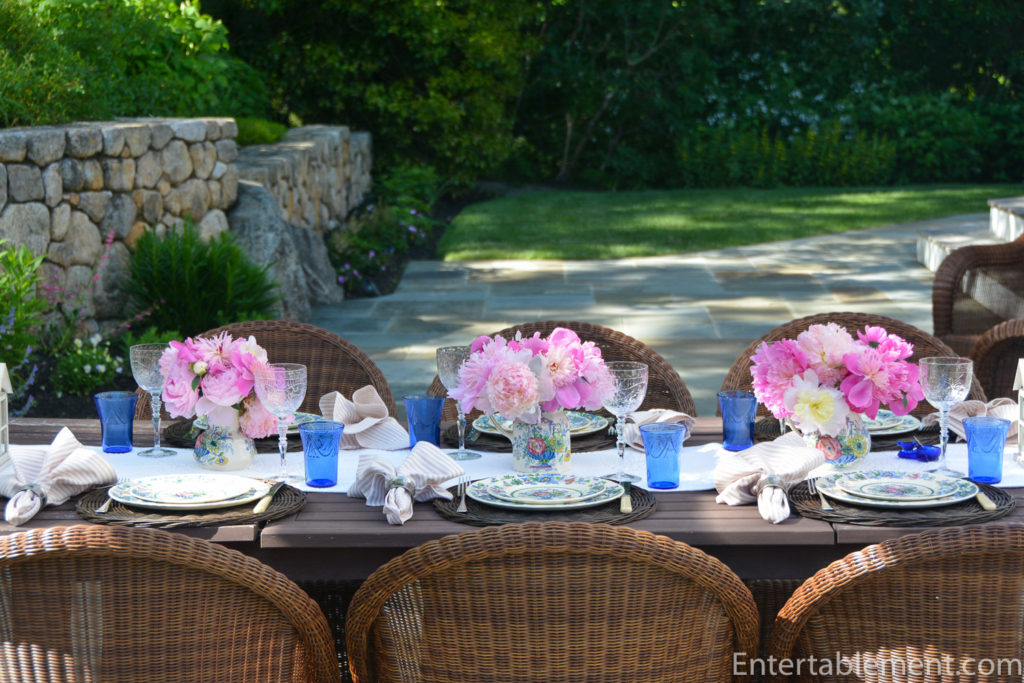
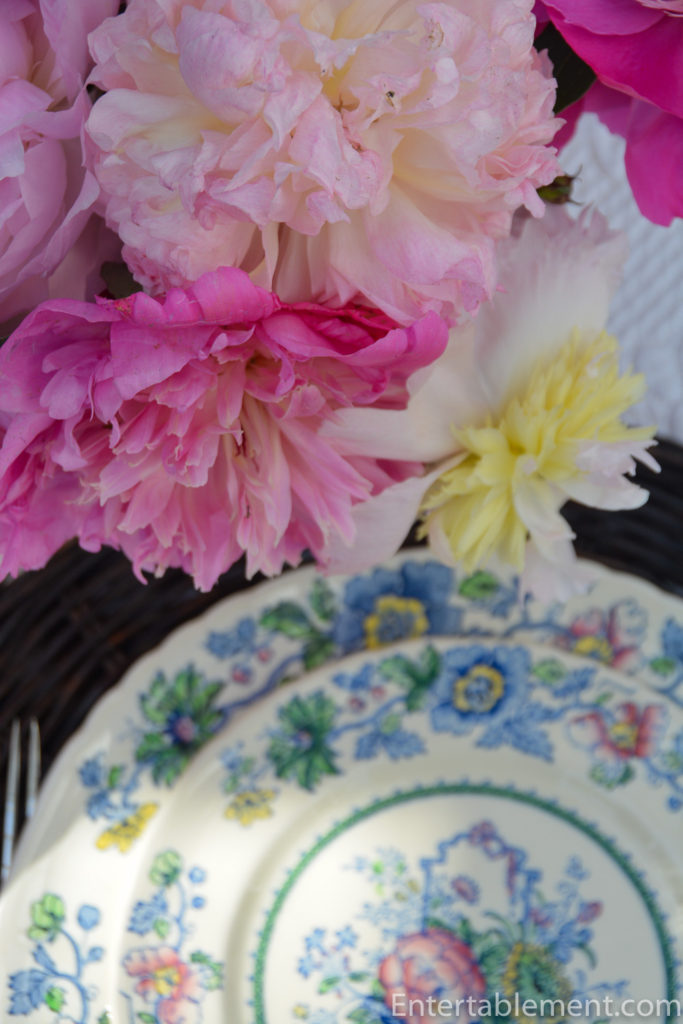



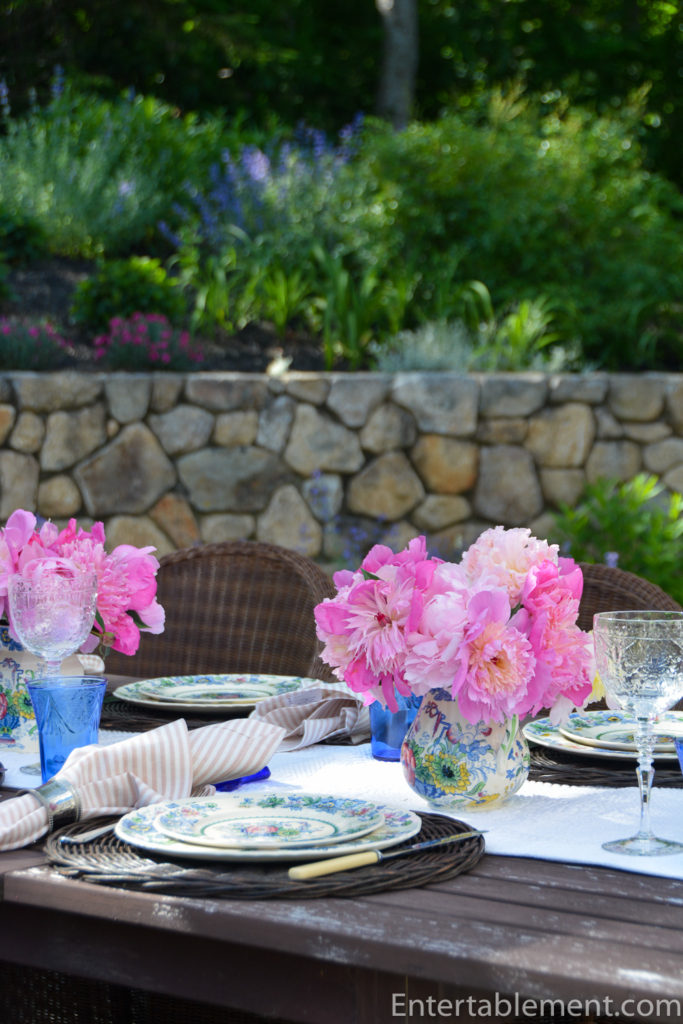
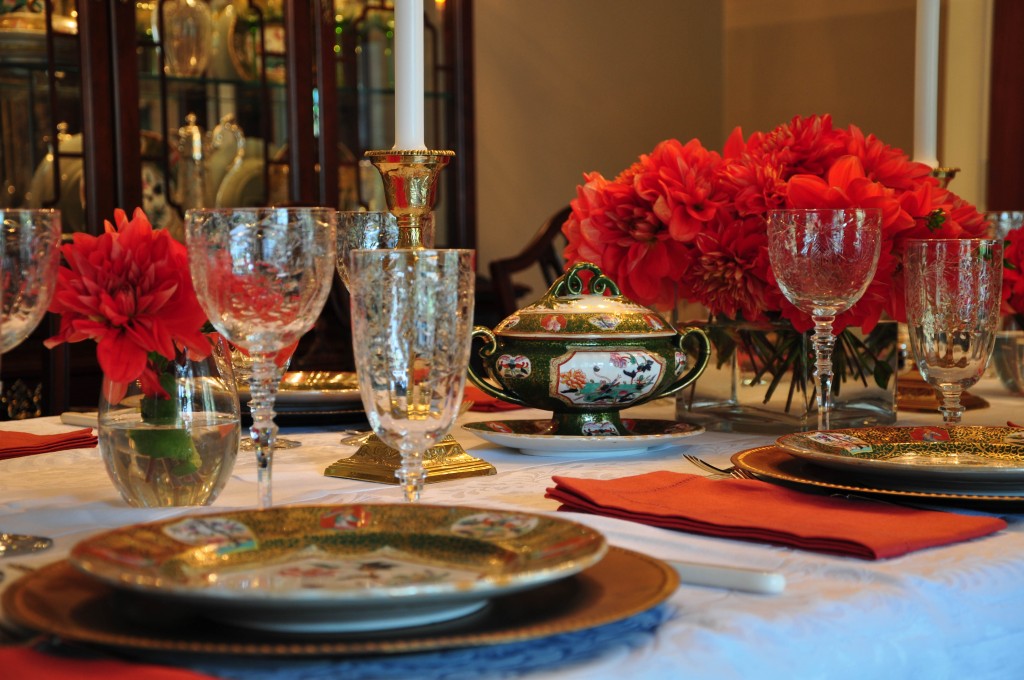








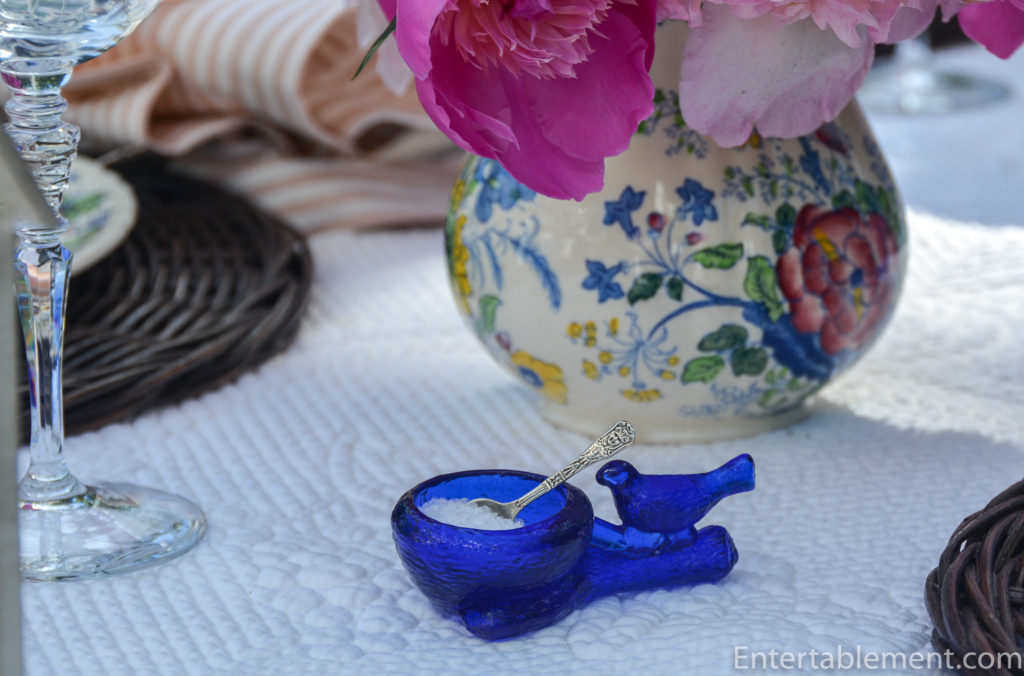
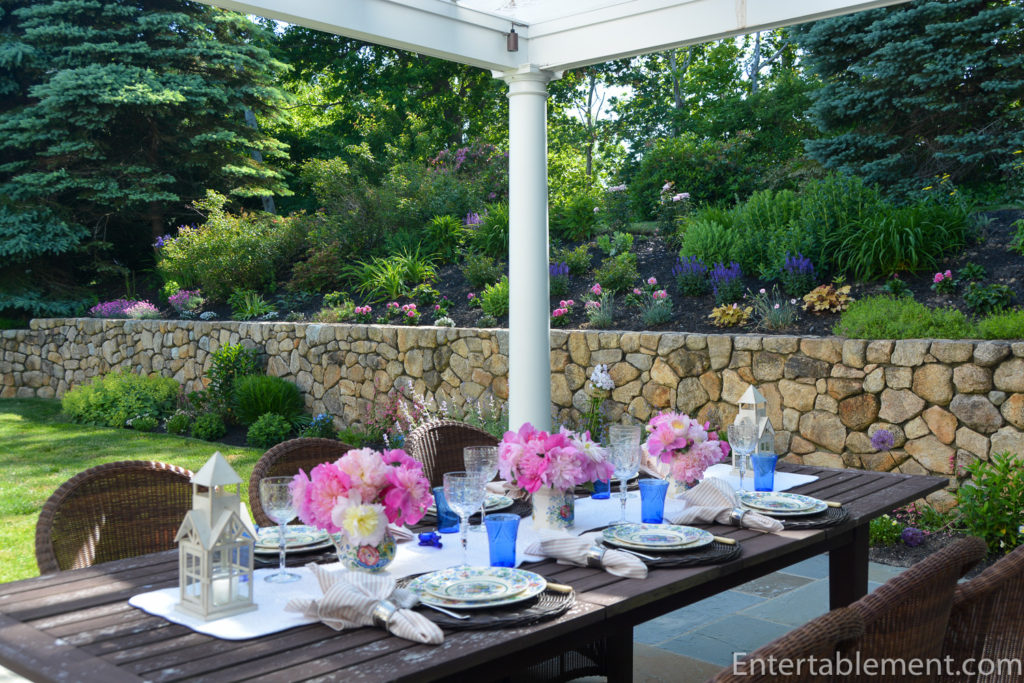

What a lovely and informative blog. I really enjoyed reading it.
Thanks, Jean. I had fun writing it! I love to do all the research.
Your table is lovely, and that pattern is gorgeous—pinning it to my pottery collection! Hugs and have a great week!
Thanks, Sandi. It’s a pin worthy pattern, for sure. Thanks for dropping by!
The peonies first caught my atttention and how I envy that you have such beautiful blooms for the picking. I love peonies. But, as I went further into your post, I fell in love with your dishes. The Strathmore Blue is just wonderful and is perfect for your table. Thank you for sharing your table and the interesting history of the Mason/Ashworth china. MM
Peonies are among my very favourites. Big, beautiful blooms and a heavenly fragrance. Trader Joe’s often has them in season, so you might try there if you have one nearby. I’m so happy to hear you enjoyed the post. I had lots of fun doing the digging into the history of Mason’s and it’s fun to share with other enthusiasts.
Loved your dishes and beautiful peonies dancing on your table. You’re lucky the rain hasn’t tumbled them over. We’re at Logan in the torrential rain which is heading your way. Better pick those peonies now. Enjoyed the Mason history on ironstone. Most of all I loved your blue bird. Very sweet. Off to SF for warm sunny weather.
Have a safe flight!
I tidied up the peonies yesterday, clipping spent flowers and sweeping up the fallen petals. There’s still quite a display, happily. They’re trussed up with rings and plant velcro tape, so they’ve come through the rain pretty well.
Shoved 12 hydrangeas into the ground yesterday, too, just in time for the rain. Ducks and plants both love this weather. Us humans, not so much.
What an informative post! And, you write so well, it’s a pleasure to read. I love everything about this table, and marvel at your skill in combining different patterns. Although you didn’t mention them, the napkins are a perfect foil for all the flowery other patterns. Can you share where you got them?
Hi Barb. So glad you enjoyed the post. . The napkins are from Pottery Barm. They’re the Wheaton, which come in a bunch of colours. I’ll update the post with the links. Have a good rest of the week.
Dear Helen,
Somehow I missed this post at the time; must have been out tending rioting peonies. I’m afraid ours don’t dance, they cavort. Finally got some 2-meter horseshoe stakes to hold them up, as they have gotten so tall!
As usual, your colours are spot on and unpredictable. I don’t know how to pick out with confidence more than one colour from a multi-colour pattern, so I always end up matchy-matchy, with all-blue glasses, serviettes, etc. How lovely this pattern, and those gorgeous cut goblets… oh my ears and whiskers!
Butter tarts…happy Canada Day!!
Hi Beatrice,
Our peonies took some corralling, too. I ended up with the horseshoe stakes plus a lot of the velcro plant tape. Heavy June rain beats mercilessly upon those blowsy mop heads, to very detrimental effect.
As to the combining patterns, I think I might do a blog on that topic. It’s probably the question I get the most. How do you decide what to put with what? It’s trial and error, and I’m often not confident at all. I start with one element and then add other colours in – usually no more than two, otherwise, it starts to look like a colour wheel in motion. In this table setting, I had gone with a more cheerful pink in a bold gingham, but it was jarring. It looked fine as one trial place setting – not so much when repeated down the table. I thought the soft pink stripe was too dull at first, but in its entirety, it looked fine, particularly with the more softly coloured peonies. Live and learn. Try, let it sit, and then redo it.
The cut goblets are cousins of the set of 11 (was 12, but sadly, life happens…) I have in Canada. Elise Abrams dug into her vast stores and found a few more of those, and while she was at it, found six of one pattern and four of another and I snapped those up for here in the Cape. They’re the identical shape and stem, but the decor on the bowl is slightly different. You wouldn’t know unless you went looking for the difference.
Mmmmmm. Butter tarts! You do know how to tempt a girl. 🙂
Have a wonderful week, whatever holiday you’re celebrating.
Best,
HK
Yes, pretty please…blog away. Show us the wrongs and rights and your step-by-step decision-making. Oh, and how to mix formal with informal. I just had a go at setting up a table with PB’s blue-and-white Arella floral embroidered table throw I couldn’t resist a couple of years ago. I’d do a link to PB, but as you know, Europe doesn’t exist for them, so I found one on ebay:
https://www.ebay.com/itm/Pottery-Barn-Arella-Embroidered-Floral-Table-Throw-50-Square-NWT/273904370538?hash=item3fc5f9036a:g:O9gAAOSw1MhdEjXT
I put pink hydrangeas in blue vases and used two shades of pink candles on crystal candlesticks with crystal-drop bobeches, Japanese blue-and-white salads, Austrian crystal wines and waters, but now I’m stuck. I need some barely-there pink serviettes, methinks. Fussy white Bavarian plates with pink and blue flowers look silly, and silver flatware is too formal for the cloth. The “right” flatware is across the pond (First World Problem lol). The table as set would give anyone dyspepsia. Sigh. Back to the drawing board…I think I’ll go out and polish the Cerbera or something.
Hmmmm. Might be too much pink in the center of the table? I think you’re on to something with the napkins, spreading the different pink shades across more visual space.
Send me a picture? I’ll try and help.
I love your blog and the way you display beautiful Masons Strathmore.
This was my parents service, bought in Suffolk in 1952 by my father who was out shopping and just happened to see it. He phoned my mother who said buy it as long as it is not plain white! In those days most decorated pottery was exported.
We celebrated festive occasions by using it and still today it is in regular use in my home. So many happy memories of people long gone, of joy and laughter and celebration.
Kind regards to you and many thanks,
Lena Tory
Thanks, Lena. My mother mentioned the same thing about the availability of coloured china after the war. They married in the early ’50s in Derbyshire and were lucky enough to get a set of Spode. My sister remembers it as Romney, but I seem to recall a plumed bird and can’t put my finger on the name of the pattern.
Glad you’re enjoying the blog!